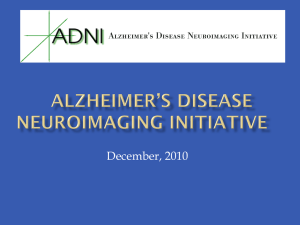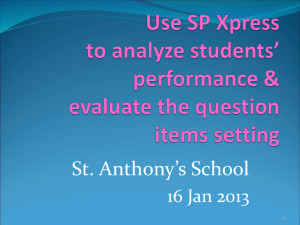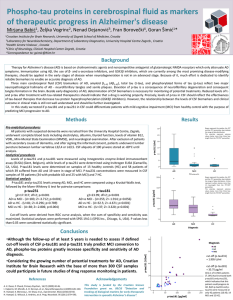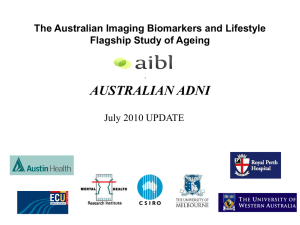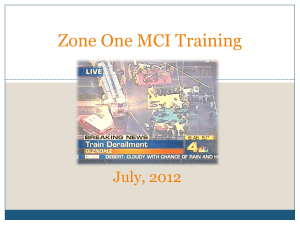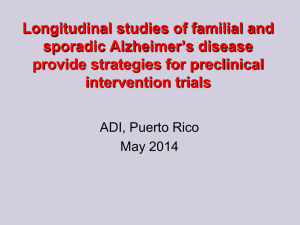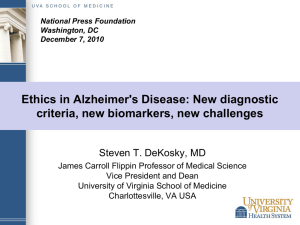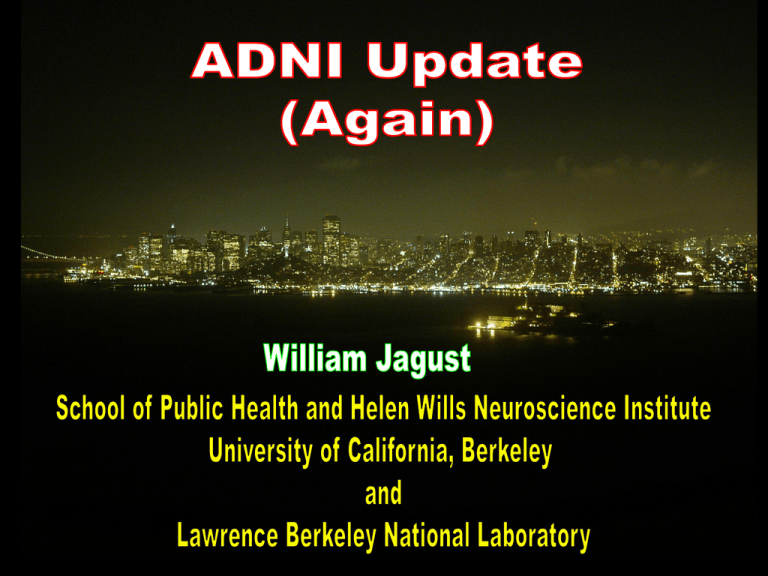
Disclosures/Conflicts
Consulting:
GE Healthcare
Bayer
Abbott
Elan/Janssen
Synarc
Genentech
Merck
ADNI PET Achievements
Literature-defined prespecified ROIs
Statistically defined ROIs
Multivariate approaches to prediction of
conversion/decline
Cross-sectional and longitudinal PIB studies
Biomarker comparisons (PIB-CSF)
Statistically Defined ROIs in AD and
MCI for Longitudinal Progression
AD
12 month trial, 25%
treatment effect
(power = 0.8, a =
0.05, 2-tailed)
61 AD patients/arm
MCI
217 MCI patients/arm
Chen et al, Neuroimage 2010
26 MCI patients with a higher HCI
71 MCI patients with a lower HCI
21 MCI patients with a smaller hippo vol
76 MCI patients with a larger hippo vol
20 MCI patients with both a higher HCI
& smaller hippo vol
38 MCI patients with neither a higher
HCI or smaller hippo vol
Chen et al, submitted
Enrollment in ADNI PiB Studies to June 2010
(All Data Are Available On The LONI Website)
Baseline – 103 Subjects at 14 PET Sites
PiB Baseline Entry Times
• NL: 19, 78±5 y/o, MMSE
• 20 subjects at ADNI true baseline
29±1
• 69 subjects at ADNI 12 months
• MCI: 65, 75±8 y/o, MMSE
• 14 subjects at ADNI 24 months
27±2
1 Yr Longitudinal Studies – 80 Subjects
• AD: 19, 73±9 y/o, MMSE
• NL: 17/19 (89%)
22±3
• MCI: 50/65 (77%)
• AD: 13/19 (68%)
2 Yr Longitudinal Studies – 39 Subjects
Total 224 PiB Scans
• NL: 11
• MCI: 26
• AD: 2
3 Yr Longitudinal Studies – 2 Subjects
• NL: 2
• MCI: 0
• AD: 0
Mathis, Univ Pittsburgh
Baseline PiB
9/19 Normals PiB+
47/65 MCI PiB+
17/19 AD PiB+
Longitudinal PiB
MCI Converters
(1-2 years)
21/47 PiB+
3/18 PiBMathis, Univ Pittsburgh
Extent of Hypometabolism as a
Predictor of MCI Conversion
Timing of
conversion
associated with
more
hypometabolic
voxels
Foster, Univ Utah
ROI Generation
Identification of ROIs from
voxelwise analyses in the
literature
Peak voxels plotted in MNI
coordinates, smoothed,
thresholded
Post
Cingulate
Gyrus
L Inf
Temporal
Gyrus
L Angular
Gyrus
R Angular
Gyrus
R Inf
Temporal
Gyrus
Jagust et al, Neurology 2009
FDG
AVLT
Combined = 12 fold
higher risk of
conversion
Landau et al, Neurology 2010
Prediction of Cognitive Decline in Normal ADNI
Participants
Define normal/abnormal cutoffs using external
samples
Classification of each subject as
normal/abnormal on each marker
Determine whether normal/abnormal status
predicts cognitive change
Participants
92 cognitively normal ADNI participants (FDG-PET, structural MRI, and ApoE
genotyping)
Mean followup
2.7 +/- 0.8 yrs
Age
Education
Female
ApoE4 carriers
MMSE
75.8 +/- 4.8 yrs
15.9 +/- 3.2 yrs
39%
23%
28.9 +/- 1.1
FDG-PET (UC Berkeley)
Sensitivity = 90%
Specificity = 93%
Alzheimer’s
patients
N = 35
Age = 67.2 +/- 10.4
57% Female
Normal older
subjects
N = 39
Age = 73.1 +/- 5.8
62% Female
Mean FDG ROI uptake (relative to cerebellum/vermis region)
Hippocampal volumes (UCSF)
Sensitivity = 94%
Specificity = 95%
Alzheimer’s
patients
N = 51
Age = 78.6 +/- 8.5
43% Female
Normal older
subjects
N = 53
Age = 74.3 +/- 7.5
53% Female
Bilateral hippocampal volume (adjusted for total intracranial volume)
Normals stratified into high/low memory
No association
between high/low
performer status and
status on any of the
normal/abnormal
markers
Median split of
normals into high/low
performers based on
baseline performance
on the Auditory Verbal
Learning Test (free
recall)
Neither group showed
significant ADAS-cog
change
Auditory Verbal Learning Test
Statistical analyses – multivariate
Low performers
Baseline
Parameter
estimate
FDG-PET
imaging
p-value
ns
Hippocampal
volume
1.31 +/- 0.58
0.03
ApoE4
carrier status
0.99 +/- 0.66
0.03
ADAS-cog
decline
age, sex,
education
Abnormal hipp volume and ApoE4 carriers 2.3 pts/yr decline relative to normal
Defining the Technical Sources of
Variability in ADNI PET Data
What is the effect of changing scanners in a
longitudinal study?
How variable are longitudinal measurements on
different scanners?
How does instrument variation compare to site
variation?
What is the effect of processing on variation?
Effects of Scanner Switch in a
Longitudinal Study
Rate of FDG
Change (in ROI)
Stable Switch Stable Switch
Normals
MCI
Stable Switch
AD
Variability by Scanner
HRRT
2
2
6
16
7
SD of Rate
of Change
Normal
MCI
AD
The Future: ADNI2 and GO
Cross-sectional and longitudinal studies of Ab
deposition with AV-45
Comparison with other biomarkers in
prediction/multivariate approaches
Comparison with other biomarkers as outcomes
Replication of statistical ROI approach using
identical ROI
Further investigate sources of variability
Susan Landau
Bob Koeppe
Eric Reiman
Kewei Chen
Chet Mathis
Julie Price
Norman Foster
Dan Bandy
Danielle Harvey
Norbert Schuff
Mike Weiner
Acknowledgements
The ADNI Executive Committee, Site Investigators, Participants
National Institute on Aging/Neil Buckholtz
ISAB
Alzheimer’s Association



